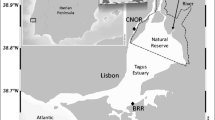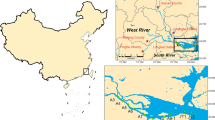Abstract
The concentrations of dissolved and particulate inorganic mercury (IHg(II)) and methylmercury (MeHg) from the contaminated Laranjo Bay (main freshwater discharge from the Antuã River) were measured by species-specific isotope dilution during six sampling campaigns at high and at low tide. Different effective riverine concentrations were calculated, based on salinity profiles, for specific hydrological conditions. The export fluxes of total Hg and MeHg (324 and 1.24 mol year−1, respectively) from the bay to the rest of the Aveiro Lagoon are much higher than the input fluxes from the Hg source (3.9 and 0.05 mol year−1) and from the Antuã River (10.4 and 0.10 mol year−1). Resuspension of contaminated sediments from Laranjo Bay is crucial for the transport of both IHg(II) and MeHg. Methylation and/or selective enrichment into biogenic particles is responsible for the mobilization of MeHg. Sorption of dissolved IHg(II) onto suspended particles limits its export flux. This is one of the rarest examples where both speciation fluxes and partitioning of mercury are studied in a contaminated coastal environment. Despite the lower fraction of total MeHg (relative to total Hg), the contaminated lagoon may have an impact on coastal areas, particularly if change in the lagoon geometry occurs, due to sea level rise.






Similar content being viewed by others
Abbreviations
- C*:
-
Effective riverine concentration
- Chl:
-
Chlorophyll
- F in :
-
Input flux
- F out :
-
Export flux
- Hg0 :
-
Elemental mercury
- HgDISS, HgPART :
-
Mercury, dissolved and particulate, respectively
- HgTOT :
-
Total mercury
- IHg(II)DISS, IHg(II)PART :
-
Inorganic mercury, dissolved and particulate, respectively
- LOD:
-
Limit of detection
- MeHgDISS, MeHgPART :
-
Methylmercury, dissolved and particulate, respectively
- MeHgTOT :
-
Total methylmercury
- Pha:
-
Phaeophytin
- Q :
-
Average monthly river discharge, historic data
- Q day :
-
Average daily river discharge, historic data
- RD:
-
River discharge (estimated during sampling)
- SPM:
-
Suspended particulate matter
- T :
-
Water temperature
References
Abreu SN, Pereira ME, Duarte AC (1998) The use of mathematical model to evaluate mercury accumulation in sediments and recovery time in a coastal lagoon (Ria de Aveiro, Portugal). Water Sci Technol 37:33–38
Almeida MA, Cunha MA, Alcântara F (2005) Relationship of bacterioplankton production with primary production and respiration in a shallow estuarine system (Ria de Aveiro, NW Portugal). Microbiol Res 160:315–328
Balcom PH, Hammerschmidt CR, Fitzgerald WF, Lamborg CH, O'Connor JS (2008) Seasonal distributions and cycling of mercury and methylmercury in the waters of New York/New Jersey Harbor Estuary. Mar Chem 109:1–17
Bloom NS, Moretto LM, Scopece P, Ugo P (2004) Seasonal cycling of mercury and monomethyl mercury in the Venice Lagoon (Italy). Mar Chem 91:85–99
Bouchet S, Amouroux D, Rodriguez-Gonzalez P, Tessier E, Monperrus M, Thouzeau G, Clavier J, Amice E, Deborde J, Bujan S, Grall J, Anschutz P (2013) MMHg production and export from intertidal sediments to the water column of a tidal lagoon (Arcachon Bay, France). Biogeochemistry 114:341–358
Boyle E, Collier R, Dengler AT, Edmond JM, Ng AC, Stallard RF (1974) On the chemical mass balance in estuaries. Geochim Cosmochim Acta 38:1719–1728
Bratkic A, Ogrinc N, Kotnik J, Faganeli J, Zagar D, Yano S, Tada A, Horvat M (2013) Mercury speciation driven by seasonal changes in a contaminated estuarine environment. Environ Res 125:171–178
Buck CS, Hammerschmidt CR, Bowman KL, Gill GA, Landing WM (2015) Flux of total mercury and methylmercury to the northern Gulf of Mexico from U.S. estuaries. Environ Sci Technol 49:13992–13999
Canu DM, Rosati G, Solidoro C, Heimbürger L-E, Acquavita A (2015) A comprehensive assessment of the mercury budget in the Marano-Grado Lagoon (Adriatic Sea) using a combined observational modeling approach. Mar Chem 177:742–752
Cerejo M, Dias JM (2007) Tidal transport and dispersal of marine toxic microalgae in a shallow, temperate coastal lagoon. Mar Environ Res 63:313–340
Cerqueira MA, Silva JF, Magalhães FP, Soares FM, Pato JJ (2008) Assessment of water pollution in the Antuã River basin (northwestern Portugal). Environ Monit Assess 142:325–335
Coelho JP, Pereira ME, Duarte A, Pardal MA (2005) Macroalgae response to a mercury contamination gradient in a temperate coastal lagoon (Ria de Aveiro, Portugal). Estuar Coast Shelf Sci 65:492–500
Coelho JP, Pato P, Henriques B, Picado A, Lillebø AI, Dias JM, Duarte AC, Pereira ME, Pardal MA (2014) Long-term monitoring of a mercury-contaminated estuary (Ria de Aveiro, Portugal): the effect of weather events and management in mercury transport. Hydrol Process 28:352–360
Cransveld A, Amouroux D, Tessier E, Koutrakis E, Ozturk AA, Bettoso N, Mieiro CL, Bérail S, Barre JPG, Sturaro N, Schnitzler J, Das K (2017) Mercury stable isotopes discriminate different populations of European seabass and trace potential Hg sources around Europe. Environ Sci Technol 51:12219–12228
Dias JM, Lopes JF, Dekeyser I (1999) Hydrological characterisation of Ria de Aveiro, Portugal, in early summer. Oceanol Acta 22:473–485
Dias JM, Lopes JF, Dekeyser I (2003) A numerical system to study the transport properties in the Ria de Aveiro lagoon. Ocean Dyn 53:220–231
Dias JM, Abrantes I, Rocha F (2007) Suspended particulate matter sources and residence time in a mesotidal lagoon. J Coastal Res SI50:1034–1039
Duck RW, da Silva JF (2012) Coastal lagoons and their evolution: a hydromorphological perspective. Estuar Coast Shelf Sci 110:2–14
Fortunato AB, Rodrigues M, Dias JM, Lopes C, Oliveira A (2013) Generating inundation maps for a coastal lagoon: a case study in the Ria de Aveiro (Portugal). Ocean Eng 64:60–71
Jiann K-T, Wen L-S (2009) Intra-annual variability of distribution patterns and fluxes of dissolved trace metals in a subtropical estuary (Danshuei River, Taiwan). J Mar Syst 75:87–99
Laurier FJG, Cossa D, Gonzalez JL, Breviere E, Sarazin G (2003) Mercury transformations and exchanges in a high turbidity estuary: the role of organic matter and amorphous oxyhydroxides. Geochim Cosmochim Acta 67:3329–3345
Leitch DR, Carrie J, Lean D, Macdonald RW, Stern GA, Wang F (2007) The delivery of mercury to the Beaufort Sea of the Arctic Ocean by the Mackenzie River. Sci Total Environ 373:178–195
Liu J, Feng X, Zhu W, Zhang X, Yin R (2012) Spatial distribution and speciation of mercury and methyl mercury in the surface water of East River (Dongjiang) tributary of Pearl River Delta, South China. Environ Sci Pollut Res 19:105–112
Lopes JF, Dias JM (2007) Residual circulation and sediment distribution in the Ria de Aveiro lagoon, Portugal. J Mar Syst 68:507–528
Lorenzen C (1967) Determination of chlorophyll and pheo-pigments: spectrophotometric equations. Limnol Oceanogr 12:343–346
Mason RP, Fitzgerald WF, Hurley J, Hanson Jr AK, Donaghay PL, Sieburth JM (1993) Mercury biogeochemical cycling in a stratified estuary. Limnol Oceanogr 38:1227–1241
Monperrus M, Gonzales PR, Amouroux D, Alonso JIG, Donard OFX (2008) Evaluating the potential and limitations of double-spiking species-specific isotope dilution analysis for accurate quantification of mercury species in different environmental matrices. Anal Bioanal Chem 390:655–666
Navarro P, Amouroux D, Thanh ND, Rochelle-Newall E, Ouillon S, Arfi R, Van TC, Mari X, Torréton J-P (2012) Fate and tidal transport of butyltin and mercury compounds in the waters of the tropical Bach Dang Estuary (Haiphong, Vietnam). Mar Pollut Bull 64:1789–1798
Pato P, Lopes C, Válega M, Lillebø AI, Dias JM, Pereira E, Duarte AC (2008) Mercury fluxes between an impacted coastal lagoon and the Atlantic Ocean. Estuar Coast Shelf Sci 76:787–796
Pereira ME, Duarte AC, Millward GE, Vale C, Abreu SN (1998) Tidal export of particulate mercury from the most contaminated area of Aveiro’s lagoon, Portugal. Sci Total Environ 213:157–163
Pereira ME, Lillebø AI, Pato P, Válega M, Coelho JP, Lopes CB, Rodrigues S, Cachada A, Otero M, Pardal MA, Duarte AC (2009) Mercury pollution in Ria de Aveiro (Portugal): a review of the system assessment. Environ Monit Assess 155:39–49
Ramalhosa E (2002) Mercúrio na Ria de Aveiro: associações, reactividade e especiação. University of Aveiro, Aveiro
Ramalhosa E, Segade SR, Pereira ME, Vale C, Duarte A (2011) Monomethylmercury behaviour in sediments collected from a mercury-contaminated lagoon. Int J Environ Anal Chem 91:49–61
Reis AT, Rodrigues SM, Araújo C, Coelho JP, Pereira E, Duarte AC (2009) Mercury contamination in the vicinity of a chlor-alkali plant and potential risks to local population. Sci Total Environ 407:2689–2700
Rumbold DG, Evans DW, Niemczyk S, Fink LE, Laine KA, Howard N, Krabbenhoft DP, Zucker M (2011) Source identification of Florida Bay’s methylmercury problem: mainland runoff versus atmospheric deposition and in situ production. Estuar Coasts 34:494–513
Sharif A, Tessier E, Bouchet S, Monperrus M, Pinaly H, Amouroux D (2013) Comparison of different air–water gas exchange models to determine gaseous mercury evasion from different European coastal lagoons and estuaries. Water Air Soil Pollut 224:1606
Sharif A, Monperrus M, Tessier E, Bouchet S, Pinaly H, Rodriguez-Gonzalez P, Maron P, Amouroux D (2014) Fate of mercury species in the coastal plume of the Adour River estuary (Bay of Biscay, SW France). Sci Total Environ 496:701–713
Siudek P, Falkowska L, Brodecka A, Kowalski A, Frankowski M, Siepak J (2015) Mercury in precipitation over the coastal zone of the southern Baltic Sea, Poland. Environ Sci Pollut Res 22:2546–2557
Stoichev T, Tessier E, Amouroux D, Almeida CM, Basto MCP, Vasconcelos VM (2016) Multiple regression analysis to assess the role of plankton on the distribution and speciation of mercury in water of a contaminated lagoon. J Hazard Mater 318:711–722
Stoichev T, Espinha Marques J, Almeida CM, De Diego A, Basto MCP, Moura R, Vasconcelos VM (2017) Simple statistical models for relating river discharge with precipitation and air temperature—case study of river Vouga (Portugal). Front Earth Sci 11:203–213
UNEP (2013) United Nations environment program, global mercury assessment 2013: sources, emissions, releases and environmental transport. UNEP Chemicals Branch, Geneva
Wängberg I, Munthe J, Amouroux D, Andersson ME, Fajon V, Ferrara R, Gårdfeldt K, Horvat M, Mamane Y, Melamed E, Monperrus M, Ogrinc N, Yossef O, Pirrone N, Sommar J, Sprovieri F (2008) Atmospheric mercury at Mediterranean coastal stations. Environ Fluid Mech 8:101–116
Wen L-S, Jiann K-T, Liu K-K (2008) Seasonal variation and flux of dissolved nutrients in the Danshuei Estuary, Taiwan: a hypoxic subtropical mountain river. Estuar Coast Shelf Sci 78:694–704
Funding
T. Stoichev is grateful to the Foundation of Science and Technology (Portugal) for fellowship SFRH/BPD/88675/2012, co-financed by Programa Operacional Potencial Humano (POPH) / Fundo Social Europeu (FSE). The financial support of the European SUDOE Interreg IVB Programme through the Orque-Sudoe Project is acknowledged.
Author information
Authors and Affiliations
Corresponding author
Additional information
Responsible editor: Philippe Garrigues
Rights and permissions
About this article
Cite this article
Stoichev, T., Tessier, E., Almeida, C.M.R. et al. Flux model to estimate the transport of mercury species in a contaminated lagoon (Ria de Aveiro, Portugal). Environ Sci Pollut Res 25, 17371–17382 (2018). https://doi.org/10.1007/s11356-018-1925-2
Received:
Accepted:
Published:
Issue Date:
DOI: https://doi.org/10.1007/s11356-018-1925-2




